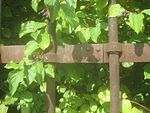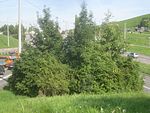Sanctuary (Stuttgart)
| Sanctuary | |
|---|---|
 View from the southeast, 2013
|
|
| Surname | Sanctuary |
| object | Landscape architectural conical installation |
| Artist | Herman de Vries |
| execution | Fred Schmalz smithy, Knetzgau |
| Construction year | 1993 |
| location | Stuttgart , Leibfriedscher Garden |
| Height above sea level | approx. 295 m |
| material | Steel, gold leaf |
| Dimensions | Diameter: 11 m, height: 2.85 m |
| Number of bars | about 170 |
The Sanctuarium is a landscape-architectural-conical installation by the Dutch conceptual artist Herman de Vries at the north-western tip of the Leibfried Garden in Stuttgart.
The Sanctuarium (shrine) is one of the art stations that were built for the International Horticultural Exhibition 1993 (IGA '93) in the park landscape of the Green U in Stuttgart and were preserved after the exhibition.
Note: Numbers in brackets, e.g. B. (12), refer to the corresponding numbers in the plan of the Leibfried Garden.
location
The sanctuary (16) is located at the north-western tip of the Leibfried Garden and forms a counterpoint to the Gate of Hope (18) by Dan Graham in the eastern corner of the park. Below Heilbronner Straße (1) meets Pragstraße (2), both of which are among the busiest streets in Stuttgart.
"It is precisely in this corner, between the sheet metal snakes that roll up and down the slopes, in the middle of the smoke hood of the exhaust gases, that Herman de Vries has erected his sanctuary, his sanctuary."
The Leibfriedsche Garten functions within the Green U , a closed green area eight kilometers in length, as a link between Rosenstein Park and Wartberg and the adjacent Killesberg Park . The Sanctuarium is located in the Stuttgart-Nord district of Stuttgart on the Pragsattel , it is located in a blind corner of the park, because the transition from Rosensteinpark is in its eastern corner and the transition to the Wartberg is in the southwest corner.
Access
The sanctuary can be reached in several ways (paths 1 and 3 are also suitable for the disabled):
- The Samarastege (8) to the south bridge Heilbronner Strasse and Pragstrasse. From these footbridges you have a good view of the sanctuary.
- If you walk further northwest through the area at the confluence of the Samaraweg (9) with the Samarastege, you will get directly to the sanctuary.
- The view, which is still the least overgrown on the outside, is better observed from a further distance so as not to expose yourself to the dangers of the seething traffic. To do this, head southeast from the Pragsattel tram stop in the direction of Heilbronner Strasse (1) to a small knoll (15), from where you have a good view of the sanctuary.
description
The sanctuary is a circular district in a dead corner of the Leibfried Garden. It is enclosed by a goalless fence, which consists of approx. 170 taller steel bars of 2.85 m high. The tips of the brown-black, partially rusted steel rods are forged into lances and gilded with gold leaf. The fence is made up of approx. 25 curved grid parts anchored in the ground, approx. 1.40 m wide, held together by cross straps at the top and bottom and riveted together.
20 years after its installation in 1993, the sanctuary was densely overgrown like a jungle, in line with the intention of its creator (see concept ). At the beginning of 2018, the fence posts were still towered over by three medium-high trees, in between weeds and undergrowth without structure could be seen in between, as the website of the Stuttgart Citizens Service describes. Above all, dog rose , red dogwood and clematis were able to expand here unhindered, also oozed out to the fence and covered it.
Shortly before Easter 2018, this vegetation, which, according to the artist, represents the actual work of art, was cut back to the ground by the garden and cemetery office of the state capital Stuttgart. Herman de Vries saw this approach as a cultural offense. His concept was disturbed and it was not respected. The head of the garden department justified the action against it with a care concept, after every five to seven years a cut back within the sanctuary was planned. De Vries denies that this was agreed with him and wanted to examine legal action.
concept
According to Herman de Vries, the draft for his sanctuary a. a. the following guiding principles:
- “The» Sanctuarium «is a respected and protected space. The protection takes place by means of a heavy steel fence [...]. In this space nature is free from human interference, a shelter for nature manifestation in an extreme environment. [...]. In between, the "Sanctuary" is completely different. The content now, spring 1993, is still completely empty. A promising void. What will nature do here? Surely it will do something, let it happen, even in this toxic exhaust gas atmosphere it will manifest itself without our intervention. "
- “So this Stuttgart» Sanctuarium «is also a challenge to look and reflect, and at this point it is also a defense against a threat from our too one-sidedly developed technological-commercial culture, and for my part I see it as a cultural choice in the knowledge of ignorance and the need for insight. "
- “The flora that will develop in the» Sanctuary «will be small at the beginning. Some will call it "weeds" on a superficial view, but this term comes from a completely different context [...], namely from the situation of the garden and arable land set up for agricultural production. Here man has created a condition where certain plants in large or small-scale monoculture (culture!) Have to fight other plants as competitors. "
- “The art is not to be seen in the first place in the design of the steel fence and its execution. That is the framework. The most important thing takes place within this fence. It is the plants that settle there, especially the very first small ones. "
literature
- Sanctuaries . In: Mel Gooding: Herman de Vries. Chance and Change , London 2006.
- Christoph Gunßer: The international horticultural exhibition Iga Expo '93 in Stuttgart . in: Deutsche Bauzeitung db. Journal for architects and civil engineers 127.1993, issue 6, pages 14–28, here: 23–24.
- Susanne Müller-Baji: Sanctuary in Stuttgart-Feuerbach. Mourning for art. In: Stuttgarter Nachrichten, April 18, 2018, online .
- City of Stuttgart (editor): Herman de Vries: Sanctuarium, 1993 , online .
- Jörg Scheller: Herman de Vries, Sanctuarium, 1993 . In: Bärbel Küster (editor); Wolfram Janzer (photos): Sculptures of the 20th Century in Stuttgart , Heidelberg 2006, pages 218–221.
- Herman de Vries; Andreas Meier (editor): To be. Texts - text work - text images. [Selection of writings and pictures 1954–1995. On the occasion of the two exhibitions by Herman de Vries in the Center Pasquart in Biel (CH) February 18–9. April 1995 and in the Städtische Galerie am Fischmarkt, Erfurt, April 23–28. May 1995] , Stuttgart 1995, pages 174-178.
- Frank Werner (editor); Christof Luz (essay); Hans Luz (essay): Art-Nature-Drama. Earthworks beyond the IGA 1993 Stuttgart , Stuttgart 1993, pages [41-43].
Web links
- Sanctuarium on the website of the city of Stuttgart
Individual evidence
- ↑ The ten art stations that have been preserved are: Near the beech , Bienengarten , Egelsee , Gate of Hope , Grottenloch , Im Keuper , Sanctuarium, Stangenwald , Unter den Stangen , Villa Moser .
- ↑ The plan is based on an OpenStreetMap map.
- ↑ #Scheller 2006 , page 219.
- ↑ # Werner 1993.3 , p. [41].
- ↑ #Scheller 2006 , p. 218.
- ↑ Naturkunstwerk - shaved off ( Memento from April 6, 2018 in the Internet Archive )
- ↑ #Vries 1995 , page 174, 176, 177. - The lower case of de Vries was converted to upper / lower case. The punctuation was not changed.
Coordinates: 48 ° 48 '30.8 " N , 9 ° 11' 6.3" E







